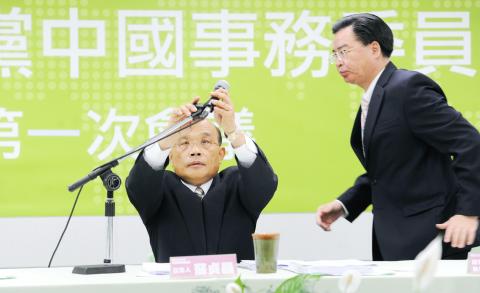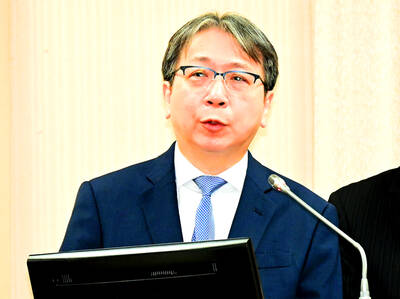The Democratic Progressive Party (DPP) took the first step toward the formulation of its cross-strait policy as its nine-member China Affairs Committee held its first meeting yesterday in the face of mounting cross-strait challenges.
“Almost every member of the committee agreed that the DPP’s core values have withstood the test of time and changing political situation. Discussions over strategic options and substantial policies are what this committee has to accomplish in the future,” committee spokesperson Cheng Wen-tsan (鄭文燦) told a press conference.
The two-hour meeting gathered all the committee members, namely committee convener and DPP Chairman Su Tseng-chang (蘇貞昌), former DPP chairperson Tsai Ing-wen (蔡英文), former premier Frank Hsieh (謝長廷), Greater Kaohsiung Mayor Chen Chu (陳菊), former premier Yu Shyi-kun, DPP legislative caucus whip Ker Chien-ming (柯建銘), Greater Tainan Mayor William Lai (賴清德), former National Security Council secretary-general Chiou I-jen (邱義仁) and former DPP secretary--general Wu Nai-jen (吳乃仁).

Photo: Lo Pei-Der, Taipei Times
Chen Ming-tung (陳明通), a National Taiwan University professor who served as Mainland Affairs Council chairman under the DPP administration, gave the keynote speech, “Taiwan’s China agenda.”
In it, he highlighted a “Taiwan Dream” based on the Taiwanese people’s high degree of consensus on sovereignty, security, human rights and economic benefits, Cheng quoted Chen as saying.
Underlining the hierarchy of the DPP’s cross-strait policy, Chiou said the party should be able to assess its basic position, strategic options and policymaking to counter persistent challenges from Beijing, Cheng said.
Former premiers Yu and Hsieh, who hold very different attitudes toward China, both laid out their main ideas in the meeting, with Yu saying that he would support any policy as long as it does not harm national interests and does not violate the DPP’s Resolution on Taiwan’s Future (台灣前途決議文) and its Normal Country Resolution (正常國家決議文).
Hsieh, who did not join the committee until this week, played down the differences between his moderate China policy and other members’ more hawkish positions, saying that the only difference between them could be his initiative of “constitutions with different interpretations (憲法各表).”
While the spokesperson said the atmosphere of the meeting was generally convivial, a DPP member who was at the meeting said on condition of anonymity that Chiou argued with Hsieh about the DPP’s attitude to the Republic of China (ROC) Constitution.
Chiou said the DPP does not accept the ROC Constitution in its entirety, while Hsieh believed the opposite, the source said.
The committee’s second meeting is scheduled for July 11, DPP Department of China Affairs director Honigmann Hong (洪財隆) said, adding that the meetings would be held every two months.

The US government has signed defense cooperation agreements with Japan and the Philippines to boost the deterrence capabilities of countries in the first island chain, a report by the National Security Bureau (NSB) showed. The main countries on the first island chain include the two nations and Taiwan. The bureau is to present the report at a meeting of the legislature’s Foreign Affairs and National Defense Committee tomorrow. The US military has deployed Typhon missile systems to Japan’s Yamaguchi Prefecture and Zambales province in the Philippines during their joint military exercises. It has also installed NMESIS anti-ship systems in Japan’s Okinawa

TRAGEDY STRIKES TAIPEI: The suspect died after falling off a building after he threw smoke grenades into Taipei Main Station and went on a killing spree in Zhongshan A 27-year-old suspect allegedly threw smoke grenades in Taipei Main Station and then proceeded to Zhongshan MRT Station in a random killing spree that resulted in the death of the suspect and two other civilians, and seven injured, including one in critical condition, as of press time last night. The suspect, identified as a man surnamed Chang Wen (張文), allegedly began the attack at Taipei Main Station, the Taipei Fire Department said, adding that it received a report at 5:24pm that smoke grenades had been thrown in the station. One man in his 50s was rushed to hospital after a cardiac arrest

‘WIN-WIN’: The Philippines, and central and eastern European countries are important potential drone cooperation partners, Minister of Foreign Affairs Lin Chia-lung said Minister of Foreign Affairs Lin Chia-lung (林佳龍) in an interview published yesterday confirmed that there are joint ventures between Taiwan and Poland in the drone industry. Lin made the remark in an exclusive interview with the Chinese-language Liberty Times (the Taipei Times’ sister paper). The government-backed Taiwan Excellence Drone International Business Opportunities Alliance and the Polish Chamber of Unmanned Systems on Wednesday last week signed a memorandum of understanding in Poland to develop a “non-China” supply chain for drones and work together on key technologies. Asked if Taiwan prioritized Poland among central and eastern European countries in drone collaboration, Lin

ON ALERT: Taiwan’s partners would issue warnings if China attempted to use Interpol to target Taiwanese, and the global body has mechanisms to prevent it, an official said China has stationed two to four people specializing in Taiwan affairs at its embassies in several democratic countries to monitor and harass Taiwanese, actions that the host nations would not tolerate, National Security Bureau (NSB) Director-General Tsai Ming-yen (蔡明彥) said yesterday. Tsai made the comments at a meeting of the legislature’s Foreign Affairs and National Defense Committee, which asked him and Minister of National Defense Wellington Koo (顧立雄) to report on potential conflicts in the Taiwan Strait and military preparedness. Democratic Progressive Party (DPP) Legislator Michelle Lin (林楚茵) expressed concern that Beijing has posted personnel from China’s Taiwan Affairs Office to its